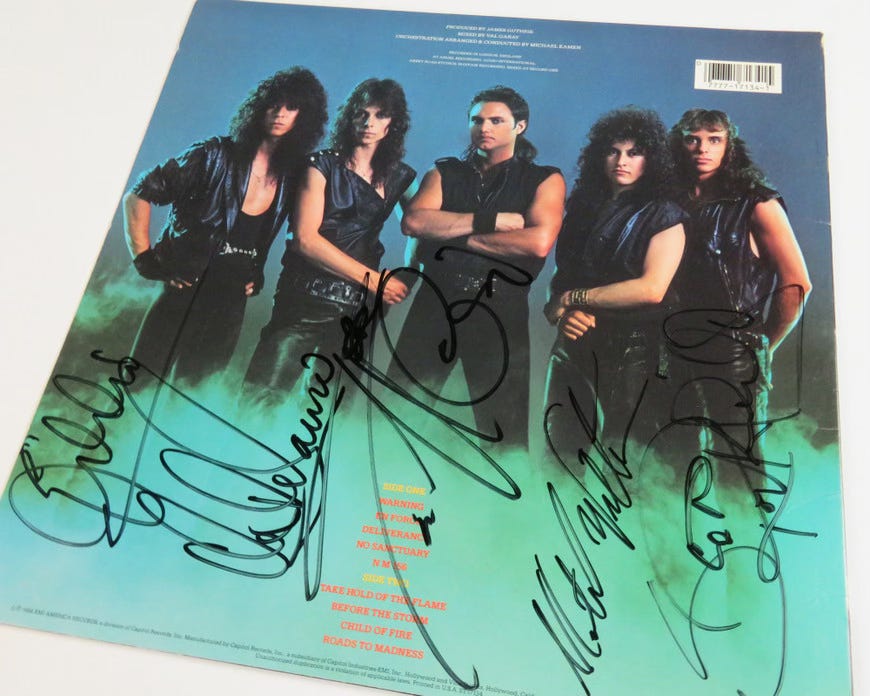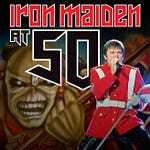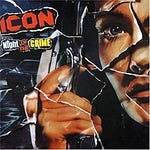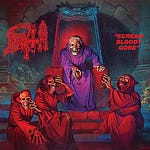It’s 1984 in Seattle. Grunge doesn’t exist yet. The glam metal explosion is just beginning. And five guys from the Pacific Northwest are making an album that sounds like nothing else—progressive ambition wrapped in new wave of British heavy metal fury, with a vocalist who can out-soar Bruce Dickinson and out-brood Ronnie James Dio.
The Warning isn’t the Queensrÿche album you know. It’s not Operation: Mindcrime‘s dystopian rock opera. It’s not Empire’s radio-friendly perfection. This is Queensrÿche in the lab, mixing maiden gallops with synth arpeggios, testing how weird they can get before EMI pulls the plug.
Spoiler: EMI pulled the plug anyway.
The Record Label Said “Not Like That”
Here’s a fact that’ll make you wince: Queensrÿche finished The Warning, sequenced it to open with “NM 156”—the album’s weirdest song, a proggy sci-fi meditation with jazzy solos and robotic vocal effects—and EMI said “absolutely not.”
The label took the finished album, remixed it without the band’s input, and completely rearranged the track listing. The band found out while they were on tour in Japan. Imagine getting that phone call. “Hey guys, great work! We changed everything. Talk soon!”
EMI wanted something safer. They pushed “Warning” up front, buried the experimental stuff deeper in the sequence. The original vision—leading with the most progressive, challenging material—got vetoed by suits who wanted radio play and MTV rotation.
Looking back, you can see both sides. Opening with “NM 156” would’ve been a bold statement of intent, announcing Queensrÿche as prog-metal visionaries from the first note. But starting with “Deliverance” coaches you in gently—familiar Iron Maiden gallops before the color shifts and the synths start doing strange things in the mix.
Still, you’ve got to wonder: what happens to this band if they get to make their album? Do they become an even weirder version of themselves? Or do they never break through at all?
That Voice Though
Geoff Tate was 24 years old when he recorded The Warning. Twenty-four. And he already sounds exactly like Geoff Tate—that operatic range, the effortless movement from chest voice to throat to head, diving low then soaring into the stratosphere within a single verse.
He’s more than operatic, though. Bruce Dickinson gets labeled as the “opera metal” guy, but Tate pushes further. He brings character to his vocals in ways Dickinson and Rob Halford don’t quite match. Even on this debut, you can hear him playing different roles within songs, setting up the theatrical storytelling that would define Operation: Mindcrime.
The mix doesn’t always serve him well. Sometimes his voice sits too far forward, a little grating when he stretches for those highest notes. Other times—like the acoustic breakdown at the end of “En Force”—he goes full Renaissance Faire bard, and it’s… a choice. You can tell he’s still figuring out how to balance power with restraint, how to sit in the band instead of on top of it.
But damn, when it works? When he locks into that rhythmic interplay with Scott Rockenfield’s drums and Chris DeGarmo’s guitar leads? That’s the Queensrÿche you’ll hear on the next three albums, fully formed and undeniable.
Double A Ball, Not the Majors
The Warning is Queensrÿche in minor league baseball phase. You can see the talent. You can see the potential. But they need more time, better coaching, sharper focus before they’re ready for the big leagues.
And that’s not a knock. Most bands never make it out of the minors. Most bands put out a decent debut and that’s it—they don’t evolve, don’t grow, don’t become Queensrÿche.
The Warning works because it’s a document of becoming. You hear the classic metal roots—those Maiden gallops on “Deliverance,” the Judas Priest twin guitar harmonies, even a Kiss-style melody on “En Force” that sounds suspiciously close to “100,000 Years.” But then “NM 156” drops in the middle of the album and suddenly you’re in uncharted territory. Synths playing dissonant chords. A guitar solo that seems to be in a different key than the rest of the song. Geoff Tate’s voice processed through effects that make him sound simultaneously robotic and anguished.
In 1984, nobody else was making metal that sounded like this. Not Maiden. Not Priest. Not Metallica, who were still figuring out thrash on Ride the Lightning. Queensrÿche was already chasing something weirder, more ambitious, more progressive.
The Songs That Almost Get There
Let’s talk hooks. Or rather, the lack of hooks.
There’s no “Silent Lucidity” on The Warning. No “Jet City Woman.” No singalong chorus that gets stuck in your head for three days. The remastered edition includes a live version of “The Lady Wore Black” from the band’s earlier EP, and the second you hear it, you notice the difference—that song has a hook. It pulls you in melodically in a way the Warning material just doesn’t quite achieve.
“Deliverance,” “No Sanctuary,” and “Take Hold of the Flame” come closest. They’ve got momentum, strong vocal melodies, enough swagger to imagine them working live. “Take Hold of the Flame” especially feels like peak Queensrÿche—it starts slow and builds into a full-on metal anthem, the kind of song that makes you want to throw your fist in the air even if you’re alone in your car.
But then you’ve got “Child of Fire” and “Warning,” which feel more generic—solid 1984 metal that could’ve been written by a dozen other bands. “Road to Madness” runs almost ten minutes and tries for epic prog ambition, but it feels contrived, like they’re forcing movements and sections instead of letting the song evolve naturally.
Here’s the thing, though: if this was the only Queensrÿche album—if they’d broken up in 1985 and The Warning was all we had—we’d be calling it a worthy debut from a band that could’ve been huge. We’d wonder what happened, why they never got another shot.
Instead, we know what happens next. Rage for Order in 1986. Operation: Mindcrime in 1988. Empire in 1990. Three albums that cement Queensrÿche as one of the most distinctive, ambitious bands in metal history.
The Warning is where that journey begins.
Seattle Before Seattle Meant Anything
There’s a fascinating counterfactual buried in this album: what if these five guys had been in Los Angeles instead of Seattle?
Think about it. Geoff Tate has the range and technique to front any band in the world. Chris DeGarmo and Michael Wilton can play circles around half the guitarists getting signed in ’84. Would they have stayed together? Or would Tate get poached to sing for Yngwie Malmsteen or some other virtuoso project? Would the guitarists get recruited for session work or bigger bands?
Seattle isolated them. In a good way. They were probably the only five guys in the city who wanted to make this specific kind of music at this level of skill. So they stuck together, developed their sound in relative obscurity, and became Queensrÿche instead of five hired guns scattered across the L.A. metal scene.
Geography matters. Queensrÿche became Queensrÿche because they were in Seattle, not L.A. or New York. They had space to be weird. They had space to fail and try again.
Forty-one years later, The Warning isn’t just a curiosity for completists. It’s a reminder that great bands don’t emerge fully formed. They become great through iteration, experimentation, and the willingness to sound a little strange before they sound revolutionary.
EMI tried to sand down Queensrÿche’s edges on this album. The band fought back by getting weirder on the next one. By Mindcrime, they’d become uncategorizable—progressive metal with punk attitude, concept album ambition with pop accessibility.
But it started here. With a 24-year-old vocalist who could out-sing anyone. With dual guitarists crafting intricate harmonies and dissonant chords. With a rhythm section that could gallop like Maiden but pivot into jazz-fusion complexity mid-song.
The Warning is Queensrÿche before they knew exactly what Queensrÿche was. And that’s exactly what makes it worth hearing.
What’s your history with The Warning? Did you discover it before or after Operation: Mindcrime? And be honest—would you have opened the album with “NM 156”?
Songs in this Episode
Intro - Roads to Madness
19:31 - Deliverance
21:12 - NM 156
29:29 - Deliverance
32:58 - 100,000 Years (KISS)
33:11 - En Force
34:27 - En Force
Outro - Warning

















